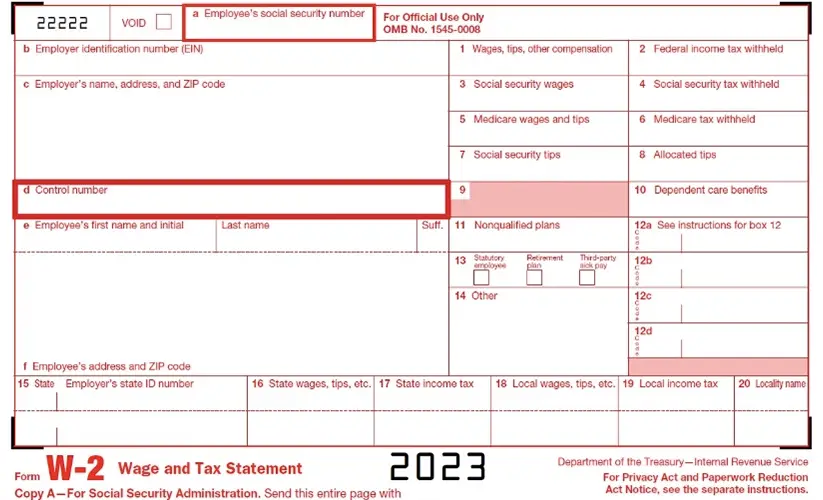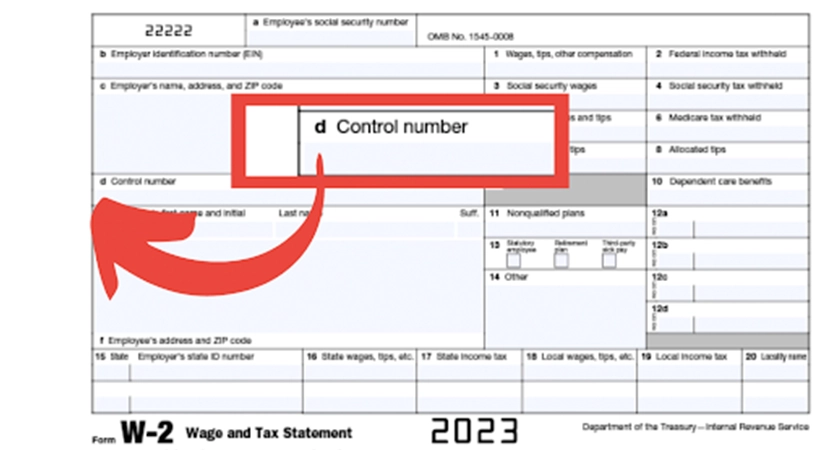
Is there a name for hypochondria about your tax forms? I’ve wondered about Box D on W-2, but now, I don’t!

Box D on Form W-2: Where Is It? What’s It for?
To locate Box D, look at the middle of the left side of the Form W-2, where it’s labeled “Control number.” It’s under Box C: Employer’s name, address and ZIP code. The control number is essential for both employer records when they report taxable wages as well as helping the IRS identify the employer and verify the accuracy of the information reported on the W-2. Essentially, it’s a 10-digit number your employer’s payroll department uses for tracking W-2s in their systems.
It’s important to note that the placement of Box-D can vary depending on the payroll provider or software used to generate the Form W-2.
If you’ve ever received a W-2 form for your taxable wages, you know that this document contains a lot of important tax information that affects your income tax return. If you notice any errors, you should contact your employer immediately to get them corrected.
What is a control number?
A control number is a unique identifier that is assigned to each Form W-2 issued by an employer. This number allows the Social Security Administration to track individual W-2s aside from using a Social Security number. It ensures that the W-2s are reported accurately for federal income tax purposes.
In addition to helping the government track W-2s, the control number is also used as a unique identifier for individuals who need to access their credit report. By providing their control number to credit reporting agencies, individuals can ensure that their credit report is accurate and up-to-date. This can be important when applying for loans or credit cards.
Why Does Form W-2 Have a Box D?
Box D on Form W-2 is used to report the control number assigned to the wages subject to tax form by your employer’s payroll processing software. This ensures that Form W-2is accurately tracked and accounted for by the government. The control number is also used as a unique identifier by credit reporting agencies to verify the accuracy of your credit report.
You can obtain a W-2 Form from various sources including your employer, the Social Security Administration, or the Internal Revenue Service. It is important to ensure that the information on your W-2 Form is correct as this information is needed for filing your federal taxes.
Uses Of Form Box-D On Form W-2
Box D on Form W-2 is for employers and their payroll departments to report a control number. This control number is designated to identify an employer’s W-2 records and does not have any major uses apart from that. While taxpayers may be tempted to leave this field blank, they should do so only if instructed to do so by the IRS. Employers can use this control number to keep track of their records and ensure that they have accurately reported their employees’ wages and tax information. The IRS also uses this number to verify the information provided in the W-2 forms during tax returns processing. Therefore, it is important to ensure that this box is accurately filled out to avoid any discrepancies or issues during tax filing. Employers must be careful to correctly report the control number to ensure that their employees receive accurate W-2 forms.
What if Box D is blank?
Box D on Form W-2 is reserved for a control number assigned by an employer’s payroll department, but what happens if this box is left blank? The good news is that a blank Box D will not affect your tax return in any way. However, it is important to confirm with your employer or payroll software provider whether or not they use control numbers and how they apply them to their W-2 forms.
Assigning control numbers is a common practice among larger organizations, as it helps to manage multiple payroll systems and data streams. However, some smaller or mid-sized employers may not use control numbers at all, which could result in a blank Box D on your W-2.
What About Box 13 on Form W-2? What do the three boxes mean?
If you’re an active participant in a retirement plan, you might see a box checked. Form W-2 is a tax document that indicates your annual income and taxes paid in a given tax year. Employers are responsible for preparing W-2 forms for their employees, which are also sent to the Social Security Administration (SSA) and the Internal Revenue Service (IRS). The W-2 form serves as an essential document that is required for filing your tax return.
One crucial component of the W-2 form is Box 13, which includes various types of information about your retirement plan contributions, statutory employee status, and other important details about your employment that may affect your tax return.
There are three options for qualified plans under the nonqualified plans.
The Retirement Plan Box
Retirement Plan is one of the checkboxes that can be found on a W-2 form. The Retirement plan box indicates whether an employee is a participant in their employer’s pension plan. As per IRS regulations, individuals qualify for membership in a pension plan if they meet certain requirements set by their employer, such as age and length of service. Contributions to retirement plans are typically made on a pre-tax basis, which reduces the income subject to federal income taxes.
Participants in a pension plan are allowed to defer a portion of their income for retirement, which can be a significant benefit in planning for a financially secure future. However, there are exceptions to the Retirement Plan checkbox being checked. For instance, if an employee receives a W-2 for legal service fringe or if they are a terminated employee who did not receive wages but still received other types of pay requiring a W-2.
The Third Party Pay Box
Third Party Pay refers to payments made by someone other than the employer, such as an insurance company or a state agency, for sick or disability leave. This is often done to help an employee cover their necessary expenses while they are unable to work.
Employers are required to report Third Party Pay on Form W-2, which is the annual wage and tax statement provided to employees. In order to do this, they must check Box 13 on the form and enter the appropriate information. This includes the total amount of Third Party Pay received during the year, as well as any other taxable fringe benefits provided to the employee.
It’s important to note that Third Party Pay is subject to federal income tax withholding and Social Security and Medicare taxes, just like regular wages. Reporting it accurately on the W-2 form helps ensure compliance with tax laws and ensures that employees receive accurate information for filing their income tax returns.
The Statutory Employee Box
A statutory employee is a type of worker that is treated as an independent contractor for some purposes and as an employee for others, as defined by the IRS tax laws. Statutory employees are subject to FICA taxes, which include Social Security and Medicare taxes.
There are four categories of workers who can be treated as statutory employees:
1) drivers and distributors who deliver goods or perform services for a company
2) full-time life insurance salespeople who sell primarily for one company
3) individuals who work at home on materials or goods supplied by an employer
4) full-time traveling or city salespeople who work on behalf of a company and regularly return to their employer’s office.
For an employer to withhold Social Security and Medicare taxes from a statutory employee, the employee must meet certain conditions, such as having a written contract that states they will not be treated as an employee for federal tax purposes. Employers can find more information about statutory employees and tax withholding in IRS Publication 15-A.

Jessie Seaman
Jessie Seaman, Esq. & EA, is a Florida attorney and IRS Enrolled Agent with over 12 years of experience in state and federal tax controversy resolution. Passionate about helping individuals and businesses navigate complex tax challenges, Jessie combines her legal expertise with a dedication to education, often mentoring future tax professionals and speaking at national conferences. A double major graduate from the University of South Florida and a Juris Doctor recipient from Florida Coastal School of Law, she has overseen tens of thousands of tax resolution cases, from simple privacy plans to high-profile matters. Jessie currently resides in Chicago, enjoying outdoor adventures with her Pomsky, Fisher.








